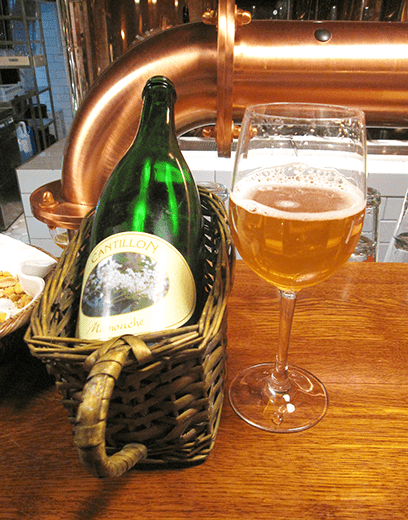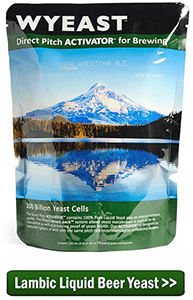 I love lambics. I don’t have much of a sweet tooth for anything except alcohol, but a good lambic seems out of my reach if for no other reason than I don’t have a building with louvred vents like they do in Belgium to capture wild yeasts. I’ve done a little searching online for lambics, but the process seems to be: “make a good ale, then add a bushel or two of apples and let ferment for another 2 years and bottle.” There has to be more to it than that. What do you recommend?
I love lambics. I don’t have much of a sweet tooth for anything except alcohol, but a good lambic seems out of my reach if for no other reason than I don’t have a building with louvred vents like they do in Belgium to capture wild yeasts. I’ve done a little searching online for lambics, but the process seems to be: “make a good ale, then add a bushel or two of apples and let ferment for another 2 years and bottle.” There has to be more to it than that. What do you recommend?
Name: Justin V.
State: Pennsylvania
—–
Hi Justin, thanks for your great question!
I can tell you right now that brewing a lambic beer recipe at home will be a labor of love. First, let me cover some of the elements that make a traditional lambic a lambic, and then I’ll share a couple lambic beer recipes.
As you probably know, lambics were developed around Belgium, specifically in the area of Brussels and the nearby town of Lembeek. Lambic can be traced back hundreds of years and is a very distinctive brew.
One of the main characteristics of lambic is that it is fermented with a variety of wild yeasts, particularly Brettanomyces. These wild yeasts and bacteria gave the beer a dry, unique flavor profile, a combination of tart, earthy, leather, fruity, and even “horse blanket.” As you mentioned, Belgian brewers would traditionally move their wort to a “cool ship,” a large, rectangular vessel with an open top, then leave the wort in the open to collect wild yeasts and bacteria through windows or vents. Some brewers would even refuse to clean those rooms for fear of disturbing the precious microbes!
Lambics can be characterized as pale and moderate in gravity. It’s traditional to have about 30% unmalted wheat in the grain bill. You might try using torrified wheat.
It’s also traditional to use aged hops when brewing a lambic beer recipe, which were used for their preservative value more than their bittering, flavoring, or aroma characteristics. The aged hops would produce a negligible bitterness that wouldn’t interfere with the sour, earthy, and complex wine-like flavors of the lambic. If you don’t have any aged hops on hand, try asking around your homebrewer friends – someone will likely have some lying around.
After the mash and boil, the beer would be moved to the cool ship, and then fermented in barrels. Sometimes fruit was added, especially cherries and raspberries, for added flavor and fermentability. Here is where the tough part comes in – lambic is usually aged one to three years or longer!
 As a beginning lambic brewer, I would recommend using a premixed lambic culture, such as the one offered by Wyeast . This blend contains the appropriate combination of yeast and bacteria to make a lambic. Some brewers will recommend that you use a dedicated set of equipment for your lambic and other “funky” beers so as to avoid cross contamination with your other brews.
As a beginning lambic brewer, I would recommend using a premixed lambic culture, such as the one offered by Wyeast . This blend contains the appropriate combination of yeast and bacteria to make a lambic. Some brewers will recommend that you use a dedicated set of equipment for your lambic and other “funky” beers so as to avoid cross contamination with your other brews.
With all the information above, I believe you have some good hints as to what to do when you brew a lambic beer recipe at home. Below are two beer recipes. The first is for a lambic-esque beer, made sour with cranberries rather than funky microbes. The second beer lambic recipe is for a more traditional lambic, and comes from the book Brewing Classic Styles by Jamil Zainasheff.
Good luck!
Cranberry “Lambic”, from A Year of Beer
(5-gallon batch, all-grain recipe)
Specs
OG: 1.053
FG: 1.018
ABV: 4.6%
Ingredients
6 lbs. Wheat malt
3.5 lbs. Pilsner malt
1 oz. Hallertau hops at :60 (2.8 AAUs)
.25 oz. Hallertau hops at :15 (.7 AAUs)
.5 oz. orange peel (5 minutes)
5/8 cup priming sugar
1 can cranberry juice concentrate added to secondary
Bavarian Wheat ale yeast
Directions
Mash crushed grains at 124˚F for 30 minutes, then raise temperature to 153˚F for 60 minutes. Raise to 168˚F for mash out. Boil wort for 75 minutes, adding hops according to schedule above. Ferment at 65˚F for 10 days, then move to secondary for 14 days. Glass carboys are recommended for fermentation.
Lambicus Piatzii, from Brewing Classic Styles
(5-gallon batch, extract recipe)
Specs
OG: 1.053
FG: 1.006
ABV: 6.2%
IBUs: 5
SRM: 4
Ingredients
5 lbs. Wheat LME
4.1 lbs. Pilsner LME
3 oz. aged hops (any European low-alpha variety) at :90 minutes
Safale US-05
Directions
Mix LME with enough hot water to make 7.7 gallons and bring to a boil. Add hops and boil for 90 minutes. Chill wort to 68˚F and pitch ale yeast (use half a packet of dry yeast or a full packet of liquid yeast without a starter). After a week, add the lambic blend. Ferment at 68˚F for six months to a year. A layer will form on the top of the beer called a pellicle. This is caused by the lambic culure and it is normal. The pellicle will often fall to the bottom of the fermenter when the beer is ready to be bottled. Bottle for 1 to 1.5 vols CO2.
Justin, this should be enough information to get you on your way to brewing a lambic beer. There are two beer recipes that you can brew at home and some insight and tips on how to get either of them brewed.
—–
David Ackley is a beer writer, brewer, and self-described “craft beer crusader.” He holds a General Certificate in Brewing from the Institute of Brewing and Distilling and is founder and editor of the Local Beer Blog.

When the recipe for the cranberry “Lambic” calls for “1 can cranberry juice concentrate added to secondary” is that pure cranberry juice concentrate or the cranberry cocktail you can get in the grocers freezer section? If it is the pure concentrate, how big is “a can”? and can you recommend a source? I cannot locate anything other than the cocktail. Thanks.
Darin, sorry for the confusion. The recipe is referring to a small can of frozen cranberry concentrate. I believe it is an 11 ounce can.
I have been trying to perfect the art of brewing Cantillon beer at my house. It is not that easy as you need to be careful to make sure that everything is done in a very timely manner.